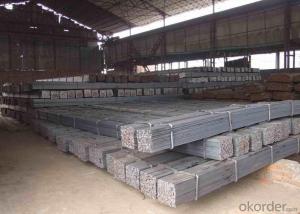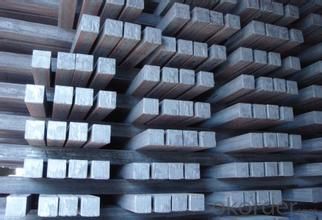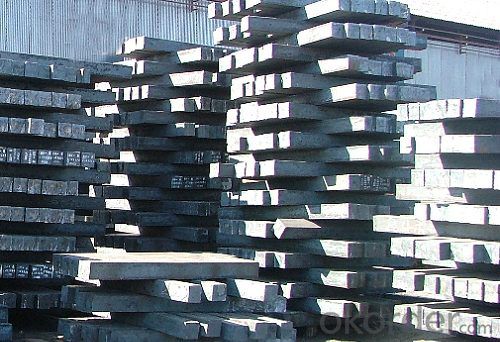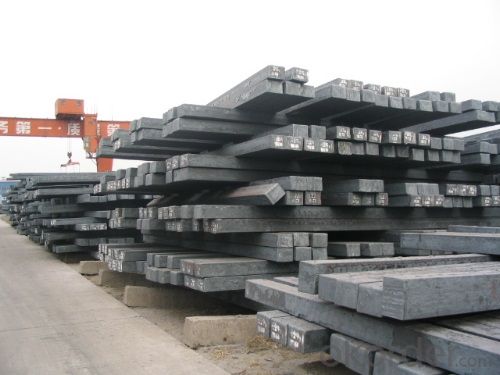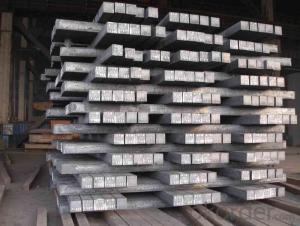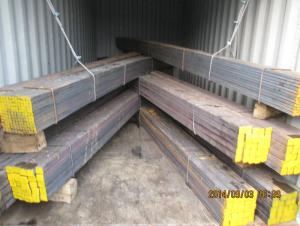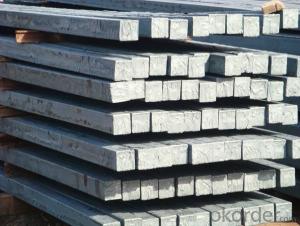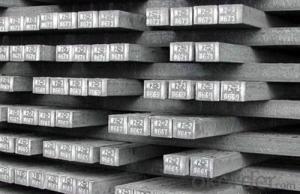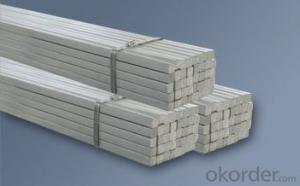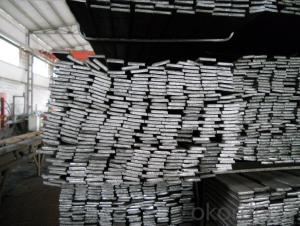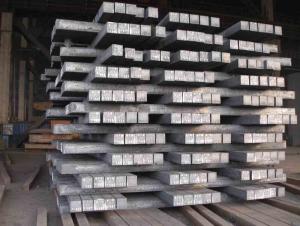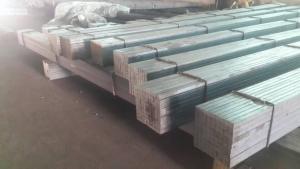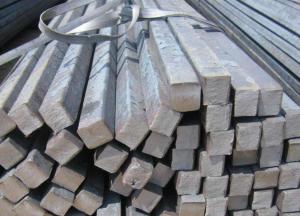Hot Rolled Steel Square Bar with the Size 100mm
- Loading Port:
- Tianjin
- Payment Terms:
- TT OR LC
- Min Order Qty:
- 2000 m.t.
- Supply Capability:
- 20000 m.t./month
OKorder Service Pledge
OKorder Financial Service
You Might Also Like
Product Description:
OKorder is offering Hot Rolled Steel Square Bar with the Size 100mm at great prices with worldwide shipping. Our supplier is a world-class manufacturer of steel, with our products utilized the world over. OKorder annually supplies products to European, North American and Asian markets. We provide quotations within 24 hours of receiving an inquiry and guarantee competitive prices.
Product Applications:
Hot Rolled Steel Square Bar with the Size 100mm can be used as steel billet for other steel products like steel angles, channels, I-beams, H-beams, steel Rebar, steel wire rod etc.
Product Advantages:
OKorder's Hot Rolled Steel Square Bar with the Size 100mm with High Quality are durable, diversified and qualified.
Main Product Features:
· Premium quality
· Prompt delivery & seaworthy packing (30 days after receiving deposit)
· Can be recycled and reused
· Mill test certification
· Professional Service
· Competitive pricing
Product Specifications:
Manufacture: Hot rolled
Grade: Q235 Q275 3SP 5SP
Certificates: ISO, SGS, BV, CIQ
Length:6m 8m 12m
Packaging: Loose
FAQ:
Q1: Why buy Materials & Equipment from OKorder.com?
A1: All products offered byOKorder.com are carefully selected from China's most reliable manufacturing enterprises. Through its ISO certifications, OKorder.com adheres to the highest standards and a commitment to supply chain safety and customer satisfaction.
Q2: How do we guarantee the quality of our products?
A2: We have established an advanced quality management system which conducts strict quality tests at every step, from raw materials to the final product. At the same time, we provide extensive follow-up service assurances as required.
Q3: How soon can we receive the product after purchase?
A3: Within three days of placing an order, we will begin production. The specific shipping date is dependent upon international and government factors, but is typically 7 to 10 workdays.
Q4: Is there any color marking or tag attached on the bundle?
A4: Yes, color marking and tag can be made.
Images:
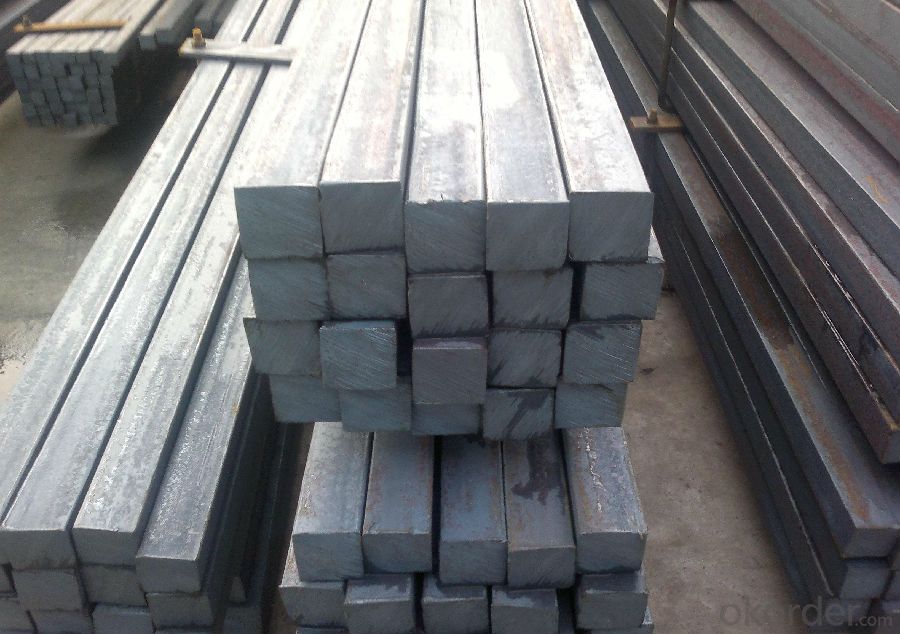
- Q: Can a steel square be used for checking the flatness of a wall stud?
- No, a steel square cannot be used for checking the flatness of a wall stud. A steel square is a measuring tool that is primarily used for marking and measuring right angles. It is not designed to assess the flatness or straightness of a surface. In order to check the flatness of a wall stud, a straightedge or a level should be used. These tools provide a more accurate measurement and can determine any irregularities or deviations in the surface.
- Q: Can a steel square be used for checking the squareness of a planer fence?
- Yes, a steel square can be used for checking the squareness of a planer fence. The straight edges of the steel square can be placed against the planer fence to determine if it is perfectly perpendicular to the table surface.
- Q: How do you use a steel square for marking stair stringers?
- In order to mark stair stringers using a steel square, several steps must be followed. Begin by determining the total rise and run of the stairway. The rise denotes the vertical distance from the floor to the top of the landing or upper floor, while the run represents the horizontal distance from the front edge of one step to the next. After obtaining these measurements, position the steel square on the edge of a piece of lumber that will serve as the stringer. Ensure that the long edge of the square is aligned with the lumber's edge, and that the shorter arm of the square is directed towards the top of the stringer. Then, utilize the rise and run measurements to mark the stringer. For the rise, locate the corresponding number on the long edge of the steel square and draw a line across the lumber. This line signifies the top of each step. For the run, locate the measurement on the shorter arm of the square and draw a parallel line to the previously marked top line. This line indicates the front edge of each step. Reiterate this process for each step, maintaining consistent measurements for both rise and run. It is important to thoroughly check the measurements for consistency in order to ensure a level and properly aligned stairway. Once all the steps have been marked on the stringer, employ a circular saw or handsaw to cut along the marked lines. Take care and cut with precision, as accuracy plays a crucial role in creating a safe and stable stairway. Lastly, test fit the stringer in place to confirm proper fitting. If necessary, make any adjustments before proceeding with the stair installation. While marking stair stringers with a steel square may require practice, it ultimately becomes a dependable and efficient method for accurately marking and cutting stringers.
- Q: Can a steel square be used for measuring roof pitch?
- Indeed, it is possible to utilize a steel square for the purpose of measuring roof pitch. A steel square, which is also referred to as a framing square or carpenter's square, is an adaptable instrument employed in the realm of carpentry and construction. Comprising a lengthy blade and a shorter tongue, it takes on the shape of an L. The blade of the square is adorned with an array of angles and measurements, rendering it advantageous for ascertaining roof pitch. In order to gauge the roof pitch utilizing a steel square, one can position the elongated blade of the square along the roof rafters or trusses, guaranteeing alignment with the lowermost edge of the roof. Then, by manipulating the angle of the square, the shorter tongue can be placed upon the roof surface. To accurately determine the roof pitch, it is necessary to inspect the measurement on the blade where it intersects with the desired pitch. The steel square's capacity to measure angles and pitch contributes to its status as a dependable tool for calculating roof slope and ensuring the appropriate installation of roofing materials. Nonetheless, it is vital to acknowledge that the usage of a steel square may demand some knowledge and practice in order to obtain precise measurements. Moreover, in certain circumstances, other specialized tools such as a digital inclinometer or a laser level may offer more accurate measurements for roof pitch.
- Q: Can a steel square be used for plumbing layout and installation?
- Plumbing layout and installation can be accomplished with the utilization of a steel square. These tools, also referred to as framing squares or carpenter squares, possess a wide range of applications, including plumbing tasks. For plumbing layout and installation purposes, a steel square is capable of measuring and marking angles, executing straight cuts, verifying squareness, and ensuring proper alignment. It proves particularly beneficial for determining right angles and guaranteeing the accurate installation of pipes at appropriate angles and positions. Moreover, steel squares are typically constructed from robust materials like steel or aluminum, providing them with durability and longevity. This durability enables them to withstand the rigors of plumbing work, such as exposure to moisture and various chemical substances. Nevertheless, it is important to acknowledge that while a steel square can be a valuable tool for plumbing layout and installation, it may not be the sole instrument required. Depending on the specific task and requirements, additional tools like levels, plumb bobs, and pipe wrenches may also be necessary. To conclude, a steel square is indeed an effective tool for accomplishing plumbing layout and installation tasks. Its versatility, durability, and ability to accurately measure and mark angles make it an invaluable resource for plumbers and other professionals within the plumbing industry.
- Q: What are some common materials used in the construction of a steel square?
- Some common materials used in the construction of a steel square include stainless steel, carbon steel, and aluminum. Stainless steel is commonly used due to its durability, corrosion resistance, and ability to withstand high temperatures. Carbon steel is also frequently used as it provides strength and is cost-effective. Aluminum is another material used in the construction of steel squares due to its lightweight nature, which makes the tool easier to handle and carry. These materials are chosen for their specific properties to ensure the steel square is reliable, accurate, and long-lasting.
- Q: What are the markings and graduations on a steel square used for?
- The utilization of the markings and graduations on a steel square encompasses a multitude of purposes within the realm of carpentry and its related fields. In the first place, these markings serve the function of measuring and delineating specific lengths on the material undergoing manipulation. It is customary for the square to possess both imperial and metric measurements, thereby facilitating meticulous and precise calculations in either measurement system. These markings play a pivotal role in guaranteeing that cuts and joints are executed with the utmost accuracy, ultimately culminating in a more refined and professional outcome. Furthermore, the graduations adorning a steel square find utility in the measurement of angles. Typically, the square is equipped with a protractor scale, which permits the determination of angles ranging from 0 to 180 degrees. This feature proves particularly advantageous when confronted with tasks such as the generation of angled cuts or the demarcation of specific angles for the purpose of joinery work. Moreover, the steel square frequently encompasses supplementary markings and characteristics that enhance various undertakings. For instance, it may incorporate a scale designated for locating the center of a circle, or a ruler edge designed to expedite swift measurements. Some squares even incorporate scribe lines, which can be employed for marking parallel lines or referencing points. All in all, the markings and graduations on a steel square represent indispensable tools for the attainment of precise measurements, angle demarcations, and a myriad of other duties within the realm of carpentry and its associated fields. Their presence ensures the achievement of exactitude and efficiency, ultimately yielding workmanship of superior quality.
- Q: What are the common mistakes to avoid when using a steel square?
- When using a steel square, there are several common mistakes that should be avoided to ensure accurate measurements and precise angles: 1. Misalignment: One of the most common mistakes is not properly aligning the steel square with the workpiece. It is essential to ensure that the square is perfectly parallel to the edges or surfaces being measured. Any misalignment can lead to inaccurate measurements and flawed angles. 2. Inconsistent pressure: Applying inconsistent pressure while marking or cutting can result in variations in the measurements. It is crucial to maintain a steady and consistent pressure while using a steel square to ensure accuracy. 3. Ignoring squareness: Over time, steel squares can lose their squareness due to wear and tear. It is important to regularly check the squareness of the tool and make any necessary adjustments or replacements. Ignoring squareness can lead to skewed measurements and inaccurate angles. 4. Incorrect positioning: Placing the steel square in the wrong position can also lead to errors. It is essential to position the square firmly against the edges or surfaces being measured to obtain accurate readings. Improper positioning can result in imprecise measurements and angles. 5. Neglecting cleanliness: Accumulated dirt, dust, or debris on the steel square can interfere with accurate measurements. Regularly clean the square to ensure smooth movements and precise readings. By avoiding these common mistakes, users can effectively utilize a steel square for measuring, marking, and cutting tasks, ensuring precise angles and accurate measurements.
- Q: How do you use a steel square to measure the width of a door jamb?
- To use a steel square to measure the width of a door jamb, follow these steps: 1. Ensure you have a steel square that has a long blade and a shorter tongue perpendicular to each other. This is often called a framing square or carpenter's square. 2. Start by holding the steel square against the inside edge of the door jamb, with the long blade touching the floor and the tongue facing towards the door opening. 3. Slide the square until the long blade is flush against one side of the door jamb. Make sure the square is held firmly and remains level. 4. Look at the measurement markings on the long blade of the square. The numbers on the blade represent inches or centimeters. Identify the mark that aligns with the opposite side of the door jamb. This will give you the width measurement of the door jamb. 5. Take note of the measurement and repeat the process on the other side of the door jamb to ensure accuracy. If the door jamb is not perfectly square, take multiple measurements at different points along the jamb to get an average width. By following these steps, you can effectively use a steel square to measure the width of a door jamb. It is important to have a steady hand and ensure the square remains level for accurate measurements.
- Q: Can a steel square be used for checking the alignment of a stair railing?
- Indeed, a stair railing's alignment can be verified using a steel square. This multipurpose tool, frequently employed in carpentry and construction, allows for precise measurements and checks for right angles. By positioning the square against the posts of the railing, one can guarantee their perpendicularity to the stair treads. By aligning the square with both the posts and treads, any deviations in alignment become readily apparent and can be promptly rectified. The steel square offers a dependable and precise means of verifying the alignment of a stair railing.
Send your message to us
Hot Rolled Steel Square Bar with the Size 100mm
- Loading Port:
- Tianjin
- Payment Terms:
- TT OR LC
- Min Order Qty:
- 2000 m.t.
- Supply Capability:
- 20000 m.t./month
OKorder Service Pledge
OKorder Financial Service
Similar products
Hot products
Hot Searches
Related keywords
